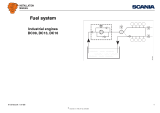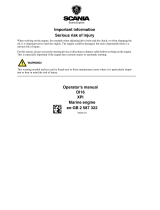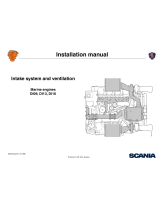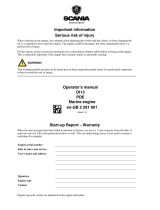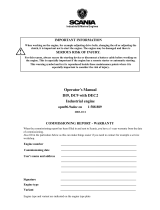Page is loading ...

02:03 Issue 7.0 en-GB
© Scania CV AB 2017, Sweden
Installation manual
Fuel system
Marine engines
DI09, DI13, DI16
333 381

INSTALLATION
MANUAL
© Scania CV AB 2017, Sweden
02:03 Issue 7.0 en-GB 2
Changes from the previous issue............................................................................3
Fuel tank...................................................................................................................3
Position................................................................................................................ 4
Fuel tank design .................................................................................................. 5
Main tank and buffer tank ................................................................................... 6
Fuel lines...................................................................................................................7
Fuel filter ..................................................................................................................8
PDE and XPI engines.......................................................................................... 8
PDE engines ...................................................................................................... 10
XPI engines ....................................................................................................... 11
Fuel cooler ..............................................................................................................12
Feed pump flow rates ............................................................................................13
Risk of fire..............................................................................................................14
Fuel grade and power for PDE engines...............................................................15
Important data.......................................................................................................17

INSTALLATION
MANUAL
© Scania CV AB 2017, Sweden
Changes from the previous issue
02:03 Issue 7.0 en-GB 3
Changes from the previous issue
The changes made in this document compared with the previous issue are marked
with a black line in the left-hand margin. The changes are also described below.
• Information about DI13 XPI has been added.
• An example illustration has been added to the Main tank and buffer tank
section.
• The information in the Feed pump flow rates
section has been made clearer.
Fuel tank
The illustration shows an example of a marine fuel tank installation.
6
7
11
9
10
8
5
1
4
2
3
384 168
Example of a fuel tank installation.
1. Bleed pipe.
2. Fuel filler pipe with filler cap.
3. Lead-through sleeve of fuel-resistant rubber.
4. Inspection hatch.
5. Baffle plate.
6. Shut-off cocks.
7. Prefilter.
8. Drain tap for sludge and water.
9. Suction pipe with bottom strainer.
10. Return pipe.
11. Ground connection.

INSTALLATION
MANUAL
© Scania CV AB 2017, Sweden
Fuel tank
02:03 Issue 7.0 en-GB 4
Position
Positioned lower than the engine
The fuel tank must not be positioned so low that the vacuum in the feed pump suction
pipe exceeds 0.3 bar. The risk of air leaks in the suction pipe increases with increased
vacuum.
If the fuel tank is mounted so low that the maximum permissible vacuum is exceeded,
or if a large fuel tank is required which cannot be mounted close to the engine, a buff-
er tank must be installed at a suitable distance and height. See Main tank and buffer
tank. If a reliable and quick starting response is required, the buffer tank should be
positioned adjacent to the engine with the lowest fuel level at the same level as the
feed pump.
Positioned higher than the engine
If the fuel tank is positioned higher than the engine, a shut-off cock must be installed
on the fuel pipe to the feed pump. This is to prevent unfiltered fuel entering the en-
gine during maintenance.
To prevent fuel leakage during filter renewal, a shut-off cock must also be installed
on the return pipe if the fuel tank is positioned higher than the engine.
Maximum permitted fuel level in the fuel tank is 3.5 m in relation to the feed pump.
Other
It is important that the fuel tank is positioned in as cool a location as possible since
the return fuel is hot and therefore raises the temperature of the fuel in the tank. If the
fuel tank is built in, the space should be well ventilated.
Power correction for PDE engines due to the fuel temperature increase is displayed
in the tables in the Fuel grade and power for PDE engines
section.

INSTALLATION
MANUAL
© Scania CV AB 2017, Sweden
Fuel tank
02:03 Issue 7.0 en-GB 5
Fuel tank design
The fuel tank must be designed as follows:
• The material for the fuel tank should be corrosion-resistant, such as stainless steel
or aluminium.
Note:
Some other materials, such as copper or hot dip galvanised sheet steel, are unsuitable
for use with diesel fuel.
Fuel tanks manufactured from materials which are not resistant to corrosion must
be treated externally with anti-corrosion paint.
• The fuel tank must not be painted internally nor be zinc-coated or galvanised.
• The fuel tanks must be fully welded.
• The fuel tanks must be equipped with internal baffle plates to prevent the fuel be-
ing thrown about in heavy seas.
• Both fuel filling components and the fuel tank must be grounded to prevent spark-
ing from static electricity.
New fuel tanks must be thoroughly cleaned and rinsed internally using clean fuel.
They must also be pressure tested to 0.3 bar.
The fuel tank should normally be drained once a year, but this may vary depending
on the quality of the fuel.
The fuel tank must have the following devices:
• A drain tap for emptying sludge and water that has sunk to the bottom.
The reason for this is that the water separated out with the prefilter follows the
return fuel back into the fuel tank.
• A ventilation or bleed line from the upper part of the fuel tank to the outside of
the hull. It should be designed so that water cannot enter and so that fuel cannot
run out when the ship is leaning heavily.
• Protection or filter to prevent contaminants entering during filling.
• Main tanks must be fitted with inspection hatches so that they can be inspected
and cleaned inside.

INSTALLATION
MANUAL
© Scania CV AB 2017, Sweden
Fuel tank
02:03 Issue 7.0 en-GB 6
Main tank and buffer tank
If the engine installation has a buffer tank and main tank, these should be designed
as follows:
• The main tank should have a sloped bottom or be on a slight incline (about 3-5°)
and have a tap at the lowest part for draining condensation.
• The buffer tank must also be fitted with a drain tap for condensation.
• The lines to the buffer tank should be as short as possible and should be mounted
in such a way that they cannot be exposed to mechanical damage.
• An electric feed pump must be fitted directly downstream of the main tank. It
must be connected so that it only pumps when the engine is running, to avoid the
risk of major leaks when the engine is at a standstill.
The flow for the electric feed pump must be 30-40% higher than the flows spec-
ified in the Feed pump flow rates
section. This is to ensure that the quantity of
return fuel is sufficient for lubrication and cooling.
• There must be a return pipe from the buffer tank to the main tank so that any sur-
plus fuel runs back to the main tank.
Note:
The return pipe should should enter below the lowest fuel level in the main tank. See
illustration.
See instructions in the Fuel tank design
section for further details.
2
3
5
6
4
1
392 389
3-5°
1. Lowest fuel level.
2. Level of return line output.
3. Return pipe.
4. Suction pipe with strainer.
5. Fuel gauge.
6. Drain tap.

INSTALLATION
MANUAL
© Scania CV AB 2017, Sweden
Fuel lines
02:03 Issue 7.0 en-GB 7
Fuel lines
The fuel lines should be designed as follows:
• The fuel lines should be routed so that the fuel cannot be heated by radiated heat
from the engine. Maximum permitted fuel temperature in the inlet pipe is 60°C.
For PDE engines, the dependence of the engine power on the fuel temperature is
stated in the table in the Fuel grade and power for PDE engines
section.
• The return pipe from the overflow valve must be routed to the fuel tank or to the
buffer tank (if fitted). For PDE engines, the return pipe and suction pipe should
have the same diameter.
Note:
The return pipe should should enter below the lowest fuel level in the fuel tank. See
previous section.
The return line must not be connected to the suction line.
• The suction pipe in the fuel tank must be placed at a sufficient distance from the
bottom of the tank, so as not to suck up deposits gathered at the bottom.
• In multi-engine installations, the fuel system should be divided into at least two
independent systems so that a fault in one of the fuel lines does not cause all en-
gines to stop.
• The fuel lines should not be made of copper as there is a risk of oxidation due to
condensation. The sulphur content in the fuel can also have a negative effect on
the copper.
The recommended minimum inside diameters of fuel lines are shown in the table.
Length of the fuel lines
Minimum inside diameter (mm)
PDE engines,
DI13 XPI
DI16 XPI
Shorter than 3 m
Suction pipe 10 14
Return line 10 10
Longer than 3 m
Suction pipe 12 16
Return line 12 12

INSTALLATION
MANUAL
© Scania CV AB 2017, Sweden
Fuel filter
02:03 Issue 7.0 en-GB 8
Fuel filter
PDE and XPI engines
The engines are equipped with an engine-mounted fuel filter. PDE engines also have
the option of commutative engine-mounted fuel filters which can be renewed during
operation.
All engines must also be fitted with a water separating prefilter. PDE engines require
one prefilter XPI engines require two prefilters, see next section. The water separat-
ing prefilter should be changed at the same intervals as the main filter.
All connections on the suction side of the feed pump must be thoroughly sealed so
that no air is drawn in during operation.
The water separating prefilter should not be installed directly on the engine and a
shut-off cock should be fitted before the filter.
The prefilters must be fitted before the feed pump and must be low in relation to the
fuel tank so that the fuel is forced into the filter. This prevents air being sucked into
the filter during draining.
The prefilters should not be installed higher than the feed pump, because that results
in an unnecessarily high suction height, making the engine more difficult to start.
In multi-engine installations, there should be extra fuel filters between each engine
and the fuel tank.
REQUIREMENT!
Measure the fuel vacuum when the installation is complete. Refer to 02:08 Measur-
ing instructions for installation inspection.
360
A=50
48,4
9,5
58,7 32,5
Ø107
12
2
1
35
12,7
373 818
Single water separating prefilter.
1. Outlet, SAE 8 P ¾" 16 UNF 2B.
2.Intake, same dimensions as outlet.
A = Free space required for prefilter renewal.

INSTALLATION
MANUAL
© Scania CV AB 2017, Sweden
Fuel filter
02:03 Issue 7.0 en-GB 9
Information about how the single prefilter harness-to-harness connector is connected
is available in 03:01 Electrical system.
It is also possible to install prefilters which are commutative. It is possible to renew
commutative fuel filters with the engine running by switching off one filter at a time.
These prefilters have a water separator and an indicator, which show when it is time
to renew the filters.
Note:
Always renew both filters at the same time.
145
124
98,5
248
385
B=254
98,5
83
85
124
SECTION A-A
476
A
A
14
1
2
373 817
Commutative water separating prefilter.
1.Intake, 7/8 14 UNF 2B straight thread with SAE J514 male JIC 37°.
2.Outlet, same dimensions as the intake.
B = Free space required for prefilter renewal.

INSTALLATION
MANUAL
© Scania CV AB 2017, Sweden
Fuel filter
02:03 Issue 7.0 en-GB 10
PDE engines
PDE engines require one water separating prefilter.
Permitted water separating prefilters for PDE engines
• Single prefilter from Scania.
• Commutative prefilter from Scania.
• Prefilter from external supplier.
If a prefilter from an external supplier is installed, a filter with a cleaning efficiency
of a maximum of 30 micrometres is recommended.
2
1
6
4
5
3
373 816
Fuel filter installation on PDE engines.
1. From fuel tank.
2. Water separating prefilter, maximum 30 micrometres.
3. Feed pump with hand pump.
4. Main fuel filter.
5. To injector.
6. Engine-mounted components.

INSTALLATION
MANUAL
© Scania CV AB 2017, Sweden
Fuel filter
02:03 Issue 7.0 en-GB 11
XPI engines
XPI engines require two water separating prefilters. The prefilters should be posi-
tioned at the same height as the engine.
First filtering step (pos. 2 in illustration), permitted water separating prefilters
• Single prefilter from Scania.
• Commutative prefilter from Scania.
• Prefilter from external supplier.
If a prefilter from an external supplier is installed in the first filtering stage, a prefilter
with a cleaning efficiency of 20-30 micrometres is recommended.
Second filtering step (pos. 3 in illustration), permitted water separating prefilter
• Only the accompanying prefilter from Scania may be used.
Note:
If no prefilter is installed in the first filtering stage, the renewal interval for the Scania
double prefilter in the second filtering stage reduces considerably.
1
2
3
8
6
4
5
7
373 049
Fuel filter installation on XPI engines.
1. From fuel tank.
2. Water separating prefilter, 20-30 micrometres.
3. Water separating prefilter from Scania. For DI13 XPI, a single filter is used for
this step.
4. Hand pump.
5. Feed pump.
6. Main fuel filter.
7. To high pressure pump.
8. Engine-mounted components.

INSTALLATION
MANUAL
© Scania CV AB 2017, Sweden
Fuel cooler
02:03 Issue 7.0 en-GB 12
Fuel cooler
If there is a risk of the fuel being heated up due to the routing of fuel lines, a fuel cool-
er can be connected in the sea water circuit upstream of the sea water pump.
338 167
Seawater-cooled fuel cooler.

INSTALLATION
MANUAL
© Scania CV AB 2017, Sweden
Feed pump flow rates
02:03 Issue 7.0 en-GB 13
Feed pump flow rates
The feed pump flow rates shown in the diagram apply at normal working pressure.
Normal working pressure is 9 to 10 bar for XPI engines and 4-6 bar for PDE engines.
The external fuel system should be designed so that any vacuum in the feed pump
suction line due to static suction height, flow resistance in fuel lines or additional fuel
filters is no greater than 0.3 bar. How the test is carried out is described in 02:08
Measuring instructions for installation inspection.
The table below gives the maximum feed pump flow to the high pressure pump and
maximum return flow to the fuel tank.
The maximum permissible back pressure in the return line is 0.35 bar for all engines.
For PDE engines, Scania recommends that the same pipe dimensions are used on the
suction line and return line. See the Fuel lines
section.
Engine type Feed pump flow Return flow
1. DI16 XPI 5 l/min 2 l/min
2. DI13 XPI 3 l/min 1 l/min
3. DI16 077M PDE 6.75 l/min 6.70 l/min
4. Other PDE engines 5 l/min 4.95 l/min
r
pm
0
90
500
1000 1500 1800 2300
1
2
3
4
5
6
L/min
7
1
3
391 310
4
2
Feed pump flow rates.
1. DI16 XPI.
2. DI13 XPI.
3. DI16 077M PDE.
4. Other PDE engines.

INSTALLATION
MANUAL
© Scania CV AB 2017, Sweden
Risk of fire
02:03 Issue 7.0 en-GB 14
Risk of fire
When working on the fuel system and handling diesel, observe the normal regula-
tions for handling flammable substances:
• Any source of ignition must be kept away from or be screened from the flamma-
ble material or area. Examples of circumstances that could cause ignition are
–welding
–smoking
– grinding with grinding machines
– sparks from static discharge or electrical equipment.
• The ventilation in the engine compartment must be satisfactory for the evacuation
of fuel vapours.
• Be careful when filling the fuel tank with fuel. If the fuel tank is close to the en-
gine, the engine should be switched off and allowed to cool.
WARNING!
Heated diesel constitutes a risk of explosion!

INSTALLATION
MANUAL
© Scania CV AB 2017, Sweden
Fuel grade and power for PDE engines
02:03 Issue 7.0 en-GB 15
Fuel grade and power for PDE engines
Different fuel properties such as viscosity, density and temperature influence the
power available from the engine. See the charts on the next page.
The listed engine power assumes fuel with a density of 0.84 kg/dm
3
and specific cal-
orific value of 42,700 kJ/kg at a fuel temperature of 15°C.
Since it is difficult to measure the exact calorific value for the fuel in question, vis-
cosity, density and temperature can be used instead to obtain a corrected engine pow-
er as a percentage for each of the properties.
The read corrected engine powers as a percentage from the figures must first be add-
ed together to obtain the final corrected engine power. Multiply this with Scania's
specified engine power to obtain the corrected engine power in kW. Then add or sub-
tract from Scania's specified engine power to obtain the corrected engine power with-
in the given tolerances.
If you have measured the current engine power for a particular engine instead and
wish to convert it to normal power, change the sign in front of the corrected engine
power in the charts.

INSTALLATION
MANUAL
© Scania CV AB 2017, Sweden
Fuel grade and power for PDE engines
02:03 Issue 7.0 en-GB 16
Engine power dependence on viscosity of fuel. Normal
value is 3 cSt at 40°C.
Engine power dependence on density of fuel. Normal
value is 0.84 kg/dm³ at 15°C.
Engine power dependence on the fuel temperature. The
reference temperature is 35°C.
.

INSTALLATION
MANUAL
© Scania CV AB 2017, Sweden
Important data
02:03 Issue 7.0 en-GB 17
Important data
Maximum vacuum in the feed pump suction line using a cleaned or new filter 0.3 bar
Max. fuel level above feed pump 3.5 m
Max. fuel temperature upstream of the feed pump 60°C
Normal fuel pressure, PDE engines 4-6 bar
Normal fuel pressure, XPI engines 9-10 bar
Maximum permitted back pressure in the return pipe 0.35 bar
Engine power dependence on viscosity of fuel See the chart on the previous page
Engine power dependence on density of fuel See the chart on the previous page
Engine output dependence on fuel temperature See the chart on the previous page
/

